Internet Technologies and Their Role in the Modern World
VerifiedAdded on 2023/04/22
|13
|3035
|186
AI Summary
This paper discusses the different internet technologies such as DNS, URL, protocols, and application layer services. It also analyzes the role and importance of internet technologies in the modern world, including how it has revolutionized business, communication, and research.
Contribute Materials
Your contribution can guide someone’s learning journey. Share your
documents today.
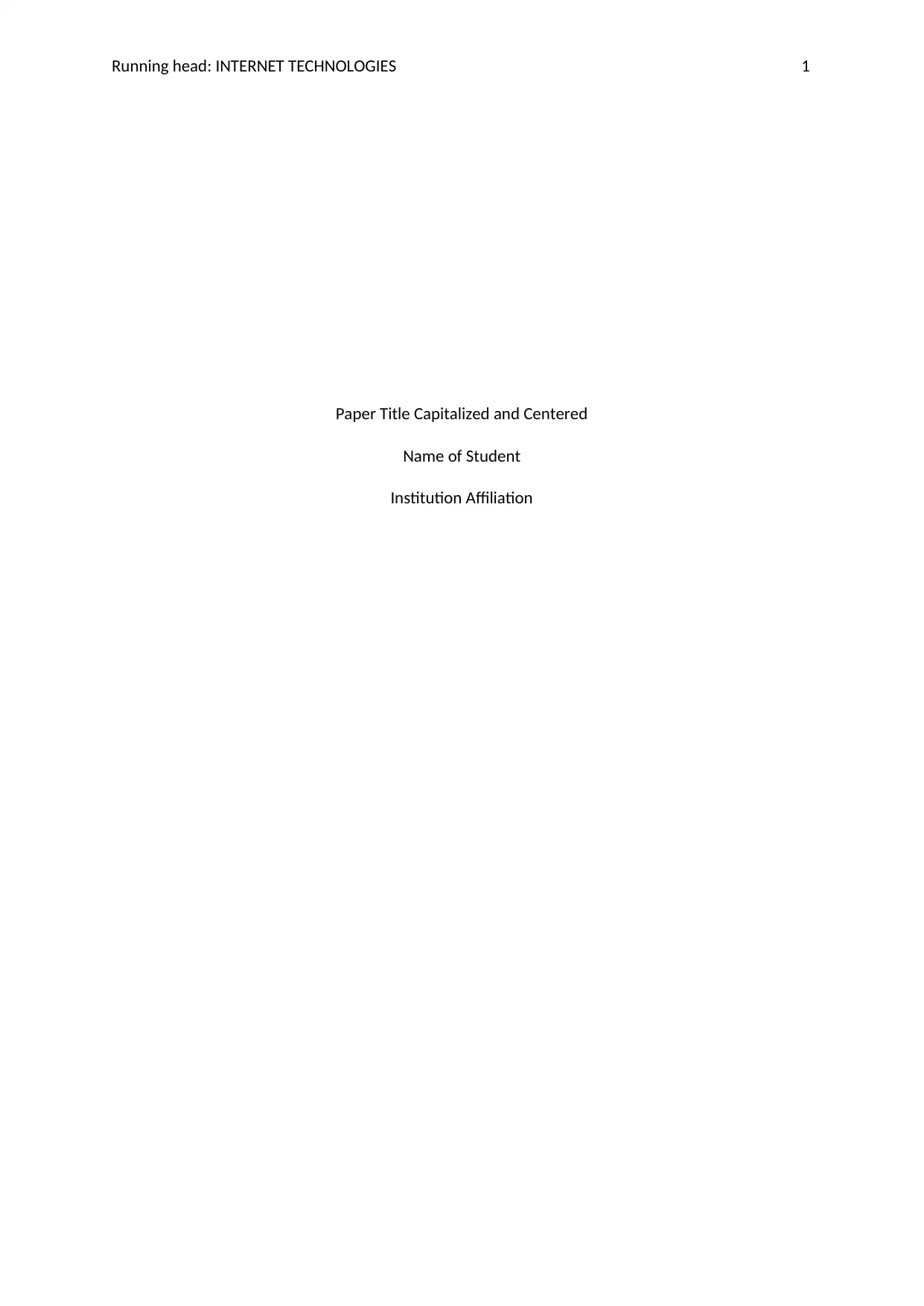
Running head: INTERNET TECHNOLOGIES 1
Paper Title Capitalized and Centered
Name of Student
Institution Affiliation
Paper Title Capitalized and Centered
Name of Student
Institution Affiliation
Secure Best Marks with AI Grader
Need help grading? Try our AI Grader for instant feedback on your assignments.
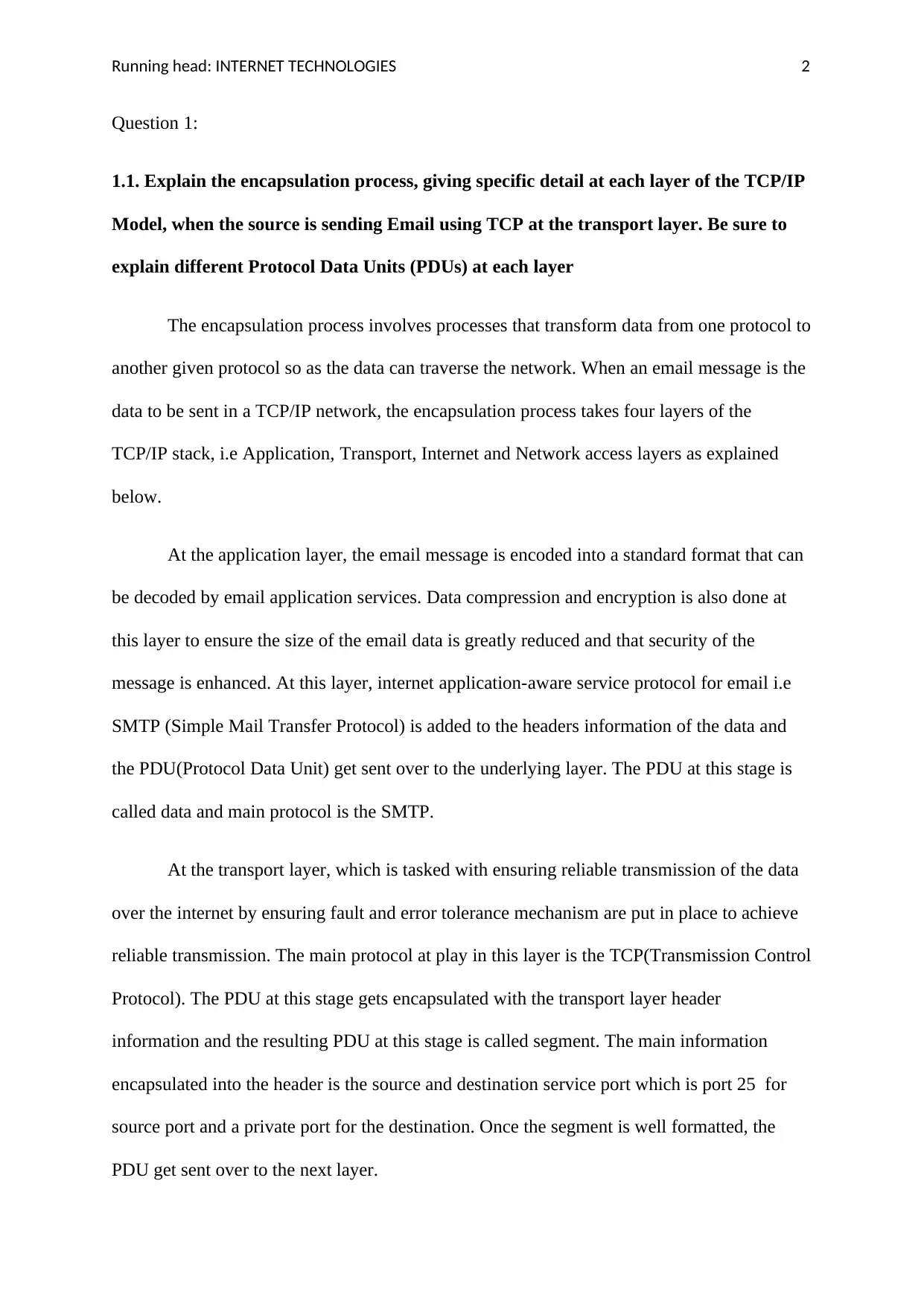
Running head: INTERNET TECHNOLOGIES 2
Question 1:
1.1. Explain the encapsulation process, giving specific detail at each layer of the TCP/IP
Model, when the source is sending Email using TCP at the transport layer. Be sure to
explain different Protocol Data Units (PDUs) at each layer
The encapsulation process involves processes that transform data from one protocol to
another given protocol so as the data can traverse the network. When an email message is the
data to be sent in a TCP/IP network, the encapsulation process takes four layers of the
TCP/IP stack, i.e Application, Transport, Internet and Network access layers as explained
below.
At the application layer, the email message is encoded into a standard format that can
be decoded by email application services. Data compression and encryption is also done at
this layer to ensure the size of the email data is greatly reduced and that security of the
message is enhanced. At this layer, internet application-aware service protocol for email i.e
SMTP (Simple Mail Transfer Protocol) is added to the headers information of the data and
the PDU(Protocol Data Unit) get sent over to the underlying layer. The PDU at this stage is
called data and main protocol is the SMTP.
At the transport layer, which is tasked with ensuring reliable transmission of the data
over the internet by ensuring fault and error tolerance mechanism are put in place to achieve
reliable transmission. The main protocol at play in this layer is the TCP(Transmission Control
Protocol). The PDU at this stage gets encapsulated with the transport layer header
information and the resulting PDU at this stage is called segment. The main information
encapsulated into the header is the source and destination service port which is port 25 for
source port and a private port for the destination. Once the segment is well formatted, the
PDU get sent over to the next layer.
Question 1:
1.1. Explain the encapsulation process, giving specific detail at each layer of the TCP/IP
Model, when the source is sending Email using TCP at the transport layer. Be sure to
explain different Protocol Data Units (PDUs) at each layer
The encapsulation process involves processes that transform data from one protocol to
another given protocol so as the data can traverse the network. When an email message is the
data to be sent in a TCP/IP network, the encapsulation process takes four layers of the
TCP/IP stack, i.e Application, Transport, Internet and Network access layers as explained
below.
At the application layer, the email message is encoded into a standard format that can
be decoded by email application services. Data compression and encryption is also done at
this layer to ensure the size of the email data is greatly reduced and that security of the
message is enhanced. At this layer, internet application-aware service protocol for email i.e
SMTP (Simple Mail Transfer Protocol) is added to the headers information of the data and
the PDU(Protocol Data Unit) get sent over to the underlying layer. The PDU at this stage is
called data and main protocol is the SMTP.
At the transport layer, which is tasked with ensuring reliable transmission of the data
over the internet by ensuring fault and error tolerance mechanism are put in place to achieve
reliable transmission. The main protocol at play in this layer is the TCP(Transmission Control
Protocol). The PDU at this stage gets encapsulated with the transport layer header
information and the resulting PDU at this stage is called segment. The main information
encapsulated into the header is the source and destination service port which is port 25 for
source port and a private port for the destination. Once the segment is well formatted, the
PDU get sent over to the next layer.
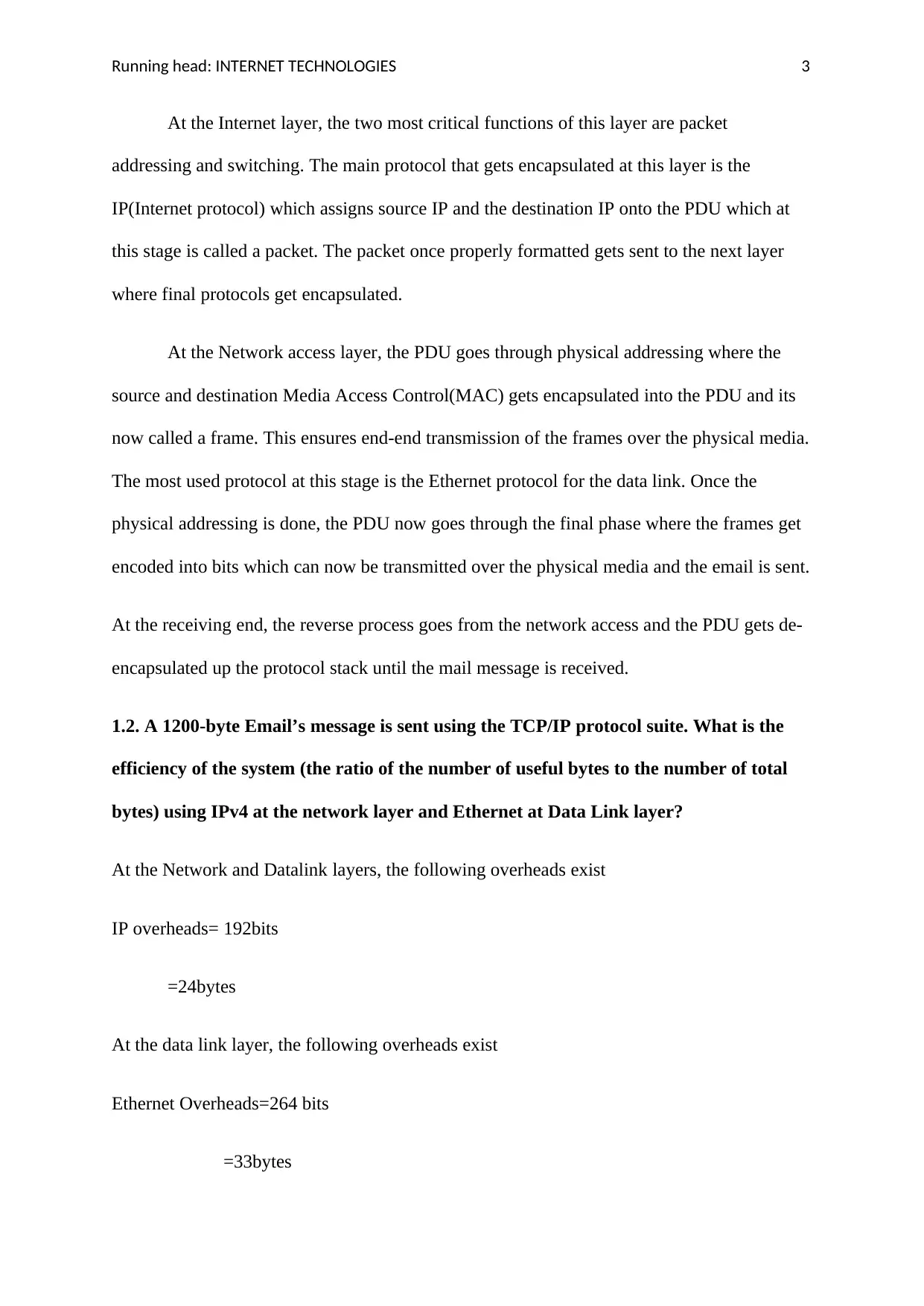
Running head: INTERNET TECHNOLOGIES 3
At the Internet layer, the two most critical functions of this layer are packet
addressing and switching. The main protocol that gets encapsulated at this layer is the
IP(Internet protocol) which assigns source IP and the destination IP onto the PDU which at
this stage is called a packet. The packet once properly formatted gets sent to the next layer
where final protocols get encapsulated.
At the Network access layer, the PDU goes through physical addressing where the
source and destination Media Access Control(MAC) gets encapsulated into the PDU and its
now called a frame. This ensures end-end transmission of the frames over the physical media.
The most used protocol at this stage is the Ethernet protocol for the data link. Once the
physical addressing is done, the PDU now goes through the final phase where the frames get
encoded into bits which can now be transmitted over the physical media and the email is sent.
At the receiving end, the reverse process goes from the network access and the PDU gets de-
encapsulated up the protocol stack until the mail message is received.
1.2. A 1200-byte Email’s message is sent using the TCP/IP protocol suite. What is the
efficiency of the system (the ratio of the number of useful bytes to the number of total
bytes) using IPv4 at the network layer and Ethernet at Data Link layer?
At the Network and Datalink layers, the following overheads exist
IP overheads= 192bits
=24bytes
At the data link layer, the following overheads exist
Ethernet Overheads=264 bits
=33bytes
At the Internet layer, the two most critical functions of this layer are packet
addressing and switching. The main protocol that gets encapsulated at this layer is the
IP(Internet protocol) which assigns source IP and the destination IP onto the PDU which at
this stage is called a packet. The packet once properly formatted gets sent to the next layer
where final protocols get encapsulated.
At the Network access layer, the PDU goes through physical addressing where the
source and destination Media Access Control(MAC) gets encapsulated into the PDU and its
now called a frame. This ensures end-end transmission of the frames over the physical media.
The most used protocol at this stage is the Ethernet protocol for the data link. Once the
physical addressing is done, the PDU now goes through the final phase where the frames get
encoded into bits which can now be transmitted over the physical media and the email is sent.
At the receiving end, the reverse process goes from the network access and the PDU gets de-
encapsulated up the protocol stack until the mail message is received.
1.2. A 1200-byte Email’s message is sent using the TCP/IP protocol suite. What is the
efficiency of the system (the ratio of the number of useful bytes to the number of total
bytes) using IPv4 at the network layer and Ethernet at Data Link layer?
At the Network and Datalink layers, the following overheads exist
IP overheads= 192bits
=24bytes
At the data link layer, the following overheads exist
Ethernet Overheads=264 bits
=33bytes
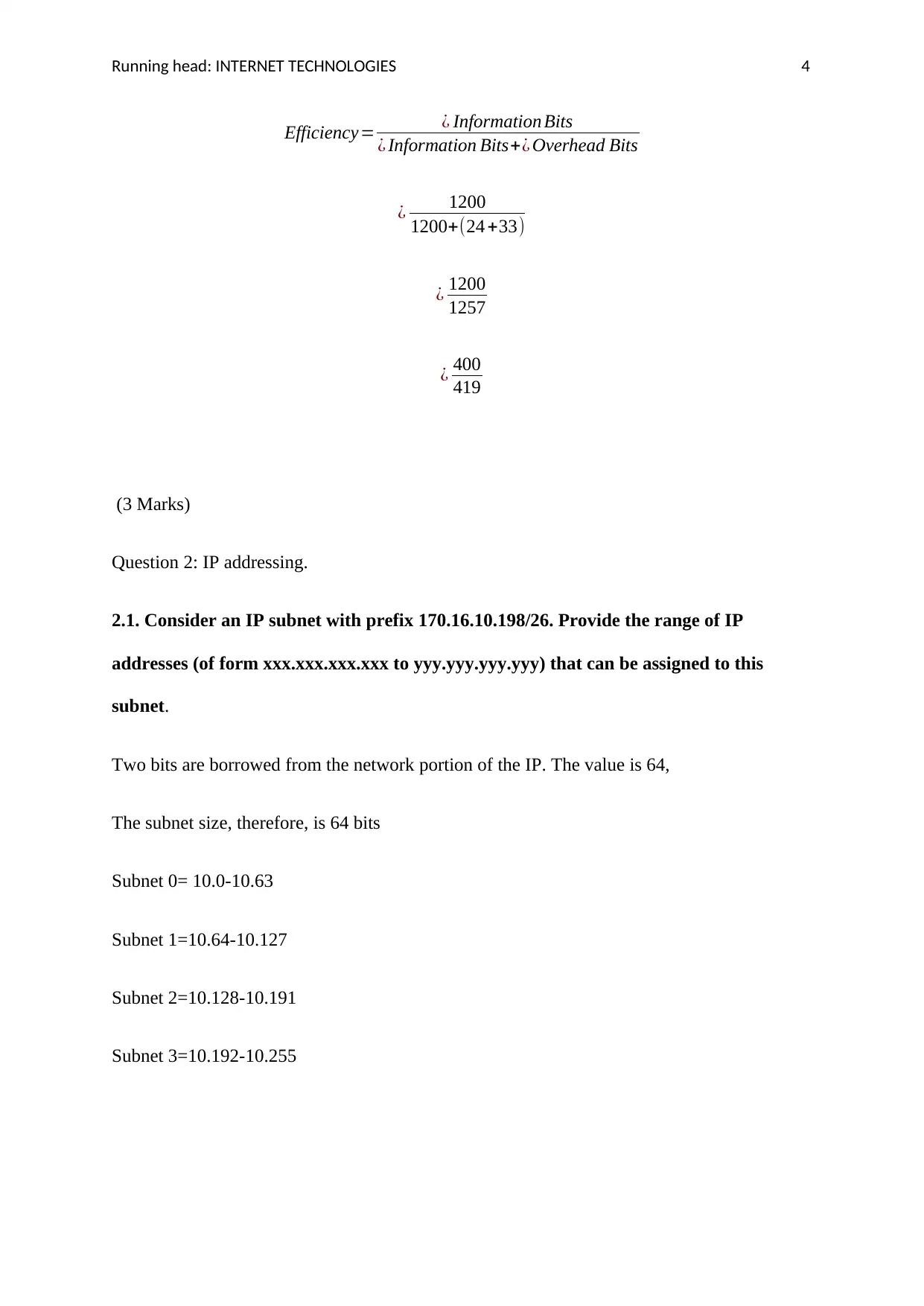
Running head: INTERNET TECHNOLOGIES 4
Efficiency= ¿ Information Bits
¿ Information Bits+¿ Overhead Bits
¿ 1200
1200+(24 +33)
¿ 1200
1257
¿ 400
419
(3 Marks)
Question 2: IP addressing.
2.1. Consider an IP subnet with prefix 170.16.10.198/26. Provide the range of IP
addresses (of form xxx.xxx.xxx.xxx to yyy.yyy.yyy.yyy) that can be assigned to this
subnet.
Two bits are borrowed from the network portion of the IP. The value is 64,
The subnet size, therefore, is 64 bits
Subnet 0= 10.0-10.63
Subnet 1=10.64-10.127
Subnet 2=10.128-10.191
Subnet 3=10.192-10.255
Efficiency= ¿ Information Bits
¿ Information Bits+¿ Overhead Bits
¿ 1200
1200+(24 +33)
¿ 1200
1257
¿ 400
419
(3 Marks)
Question 2: IP addressing.
2.1. Consider an IP subnet with prefix 170.16.10.198/26. Provide the range of IP
addresses (of form xxx.xxx.xxx.xxx to yyy.yyy.yyy.yyy) that can be assigned to this
subnet.
Two bits are borrowed from the network portion of the IP. The value is 64,
The subnet size, therefore, is 64 bits
Subnet 0= 10.0-10.63
Subnet 1=10.64-10.127
Subnet 2=10.128-10.191
Subnet 3=10.192-10.255
Secure Best Marks with AI Grader
Need help grading? Try our AI Grader for instant feedback on your assignments.
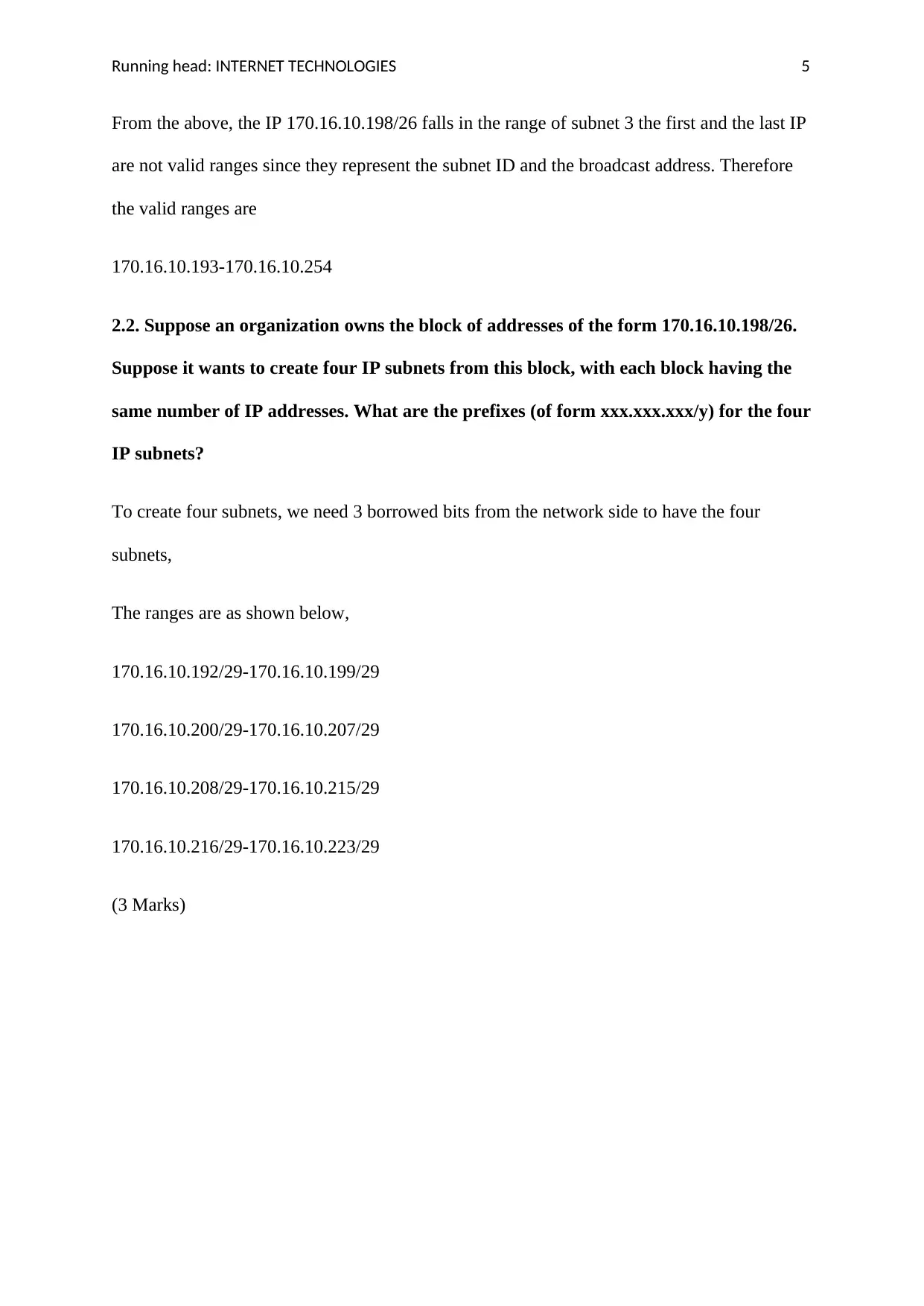
Running head: INTERNET TECHNOLOGIES 5
From the above, the IP 170.16.10.198/26 falls in the range of subnet 3 the first and the last IP
are not valid ranges since they represent the subnet ID and the broadcast address. Therefore
the valid ranges are
170.16.10.193-170.16.10.254
2.2. Suppose an organization owns the block of addresses of the form 170.16.10.198/26.
Suppose it wants to create four IP subnets from this block, with each block having the
same number of IP addresses. What are the prefixes (of form xxx.xxx.xxx/y) for the four
IP subnets?
To create four subnets, we need 3 borrowed bits from the network side to have the four
subnets,
The ranges are as shown below,
170.16.10.192/29-170.16.10.199/29
170.16.10.200/29-170.16.10.207/29
170.16.10.208/29-170.16.10.215/29
170.16.10.216/29-170.16.10.223/29
(3 Marks)
From the above, the IP 170.16.10.198/26 falls in the range of subnet 3 the first and the last IP
are not valid ranges since they represent the subnet ID and the broadcast address. Therefore
the valid ranges are
170.16.10.193-170.16.10.254
2.2. Suppose an organization owns the block of addresses of the form 170.16.10.198/26.
Suppose it wants to create four IP subnets from this block, with each block having the
same number of IP addresses. What are the prefixes (of form xxx.xxx.xxx/y) for the four
IP subnets?
To create four subnets, we need 3 borrowed bits from the network side to have the four
subnets,
The ranges are as shown below,
170.16.10.192/29-170.16.10.199/29
170.16.10.200/29-170.16.10.207/29
170.16.10.208/29-170.16.10.215/29
170.16.10.216/29-170.16.10.223/29
(3 Marks)
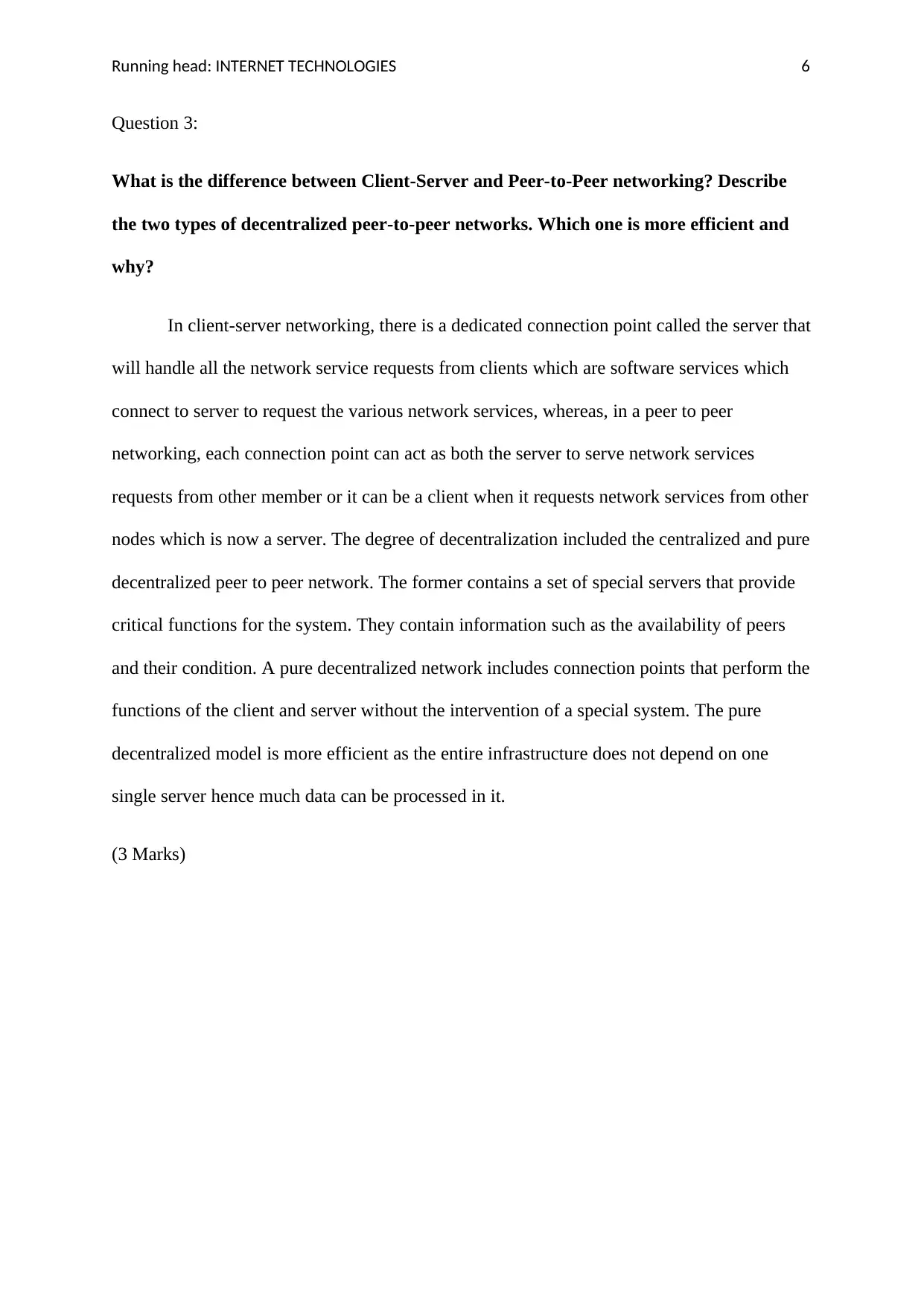
Running head: INTERNET TECHNOLOGIES 6
Question 3:
What is the difference between Client-Server and Peer-to-Peer networking? Describe
the two types of decentralized peer-to-peer networks. Which one is more efficient and
why?
In client-server networking, there is a dedicated connection point called the server that
will handle all the network service requests from clients which are software services which
connect to server to request the various network services, whereas, in a peer to peer
networking, each connection point can act as both the server to serve network services
requests from other member or it can be a client when it requests network services from other
nodes which is now a server. The degree of decentralization included the centralized and pure
decentralized peer to peer network. The former contains a set of special servers that provide
critical functions for the system. They contain information such as the availability of peers
and their condition. A pure decentralized network includes connection points that perform the
functions of the client and server without the intervention of a special system. The pure
decentralized model is more efficient as the entire infrastructure does not depend on one
single server hence much data can be processed in it.
(3 Marks)
Question 3:
What is the difference between Client-Server and Peer-to-Peer networking? Describe
the two types of decentralized peer-to-peer networks. Which one is more efficient and
why?
In client-server networking, there is a dedicated connection point called the server that
will handle all the network service requests from clients which are software services which
connect to server to request the various network services, whereas, in a peer to peer
networking, each connection point can act as both the server to serve network services
requests from other member or it can be a client when it requests network services from other
nodes which is now a server. The degree of decentralization included the centralized and pure
decentralized peer to peer network. The former contains a set of special servers that provide
critical functions for the system. They contain information such as the availability of peers
and their condition. A pure decentralized network includes connection points that perform the
functions of the client and server without the intervention of a special system. The pure
decentralized model is more efficient as the entire infrastructure does not depend on one
single server hence much data can be processed in it.
(3 Marks)
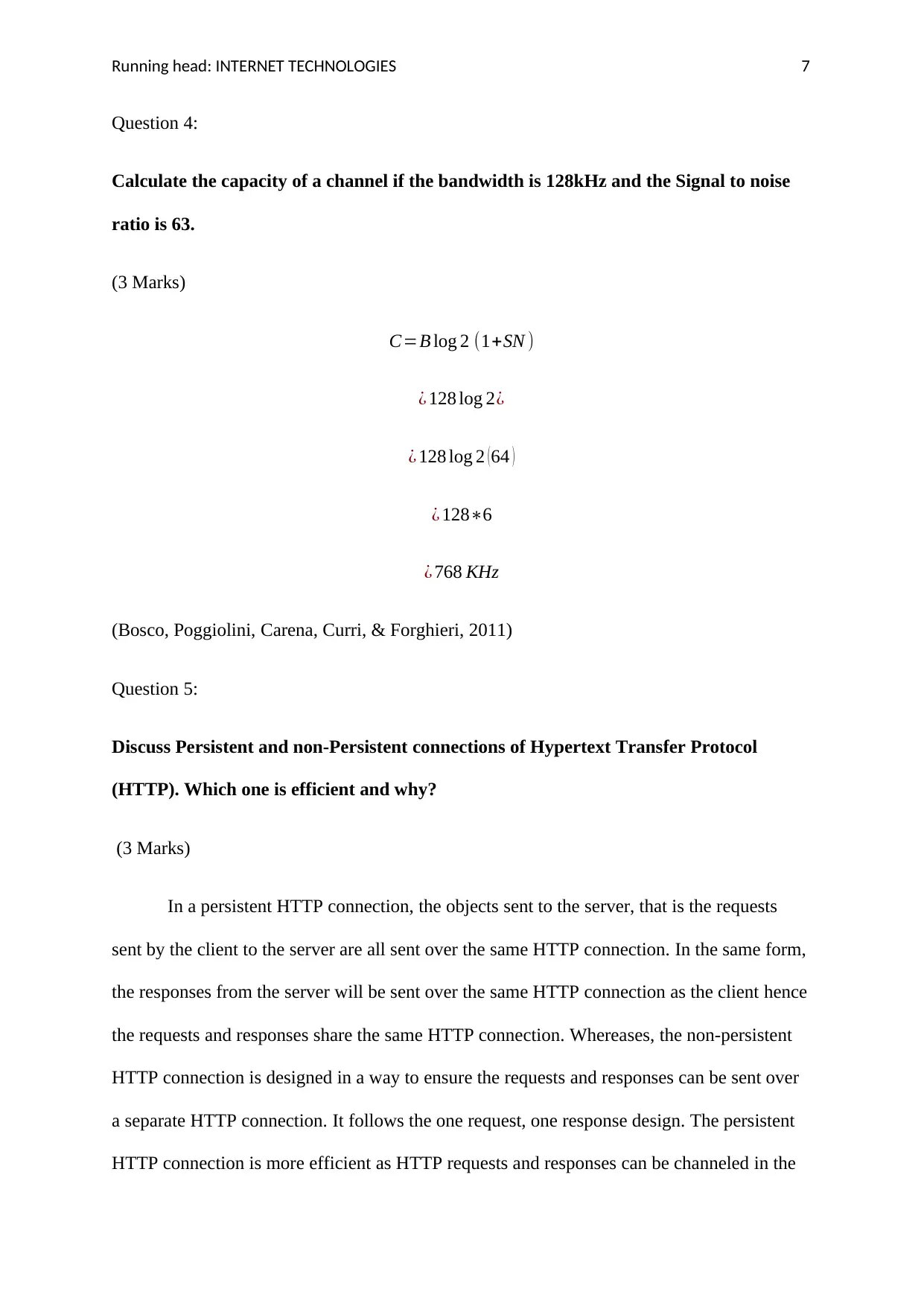
Running head: INTERNET TECHNOLOGIES 7
Question 4:
Calculate the capacity of a channel if the bandwidth is 128kHz and the Signal to noise
ratio is 63.
(3 Marks)
C=B log 2 (1+SN )
¿ 128 log 2¿
¿ 128 log 2 (64 )
¿ 128∗6
¿ 768 KHz
(Bosco, Poggiolini, Carena, Curri, & Forghieri, 2011)
Question 5:
Discuss Persistent and non-Persistent connections of Hypertext Transfer Protocol
(HTTP). Which one is efficient and why?
(3 Marks)
In a persistent HTTP connection, the objects sent to the server, that is the requests
sent by the client to the server are all sent over the same HTTP connection. In the same form,
the responses from the server will be sent over the same HTTP connection as the client hence
the requests and responses share the same HTTP connection. Whereases, the non-persistent
HTTP connection is designed in a way to ensure the requests and responses can be sent over
a separate HTTP connection. It follows the one request, one response design. The persistent
HTTP connection is more efficient as HTTP requests and responses can be channeled in the
Question 4:
Calculate the capacity of a channel if the bandwidth is 128kHz and the Signal to noise
ratio is 63.
(3 Marks)
C=B log 2 (1+SN )
¿ 128 log 2¿
¿ 128 log 2 (64 )
¿ 128∗6
¿ 768 KHz
(Bosco, Poggiolini, Carena, Curri, & Forghieri, 2011)
Question 5:
Discuss Persistent and non-Persistent connections of Hypertext Transfer Protocol
(HTTP). Which one is efficient and why?
(3 Marks)
In a persistent HTTP connection, the objects sent to the server, that is the requests
sent by the client to the server are all sent over the same HTTP connection. In the same form,
the responses from the server will be sent over the same HTTP connection as the client hence
the requests and responses share the same HTTP connection. Whereases, the non-persistent
HTTP connection is designed in a way to ensure the requests and responses can be sent over
a separate HTTP connection. It follows the one request, one response design. The persistent
HTTP connection is more efficient as HTTP requests and responses can be channeled in the
Paraphrase This Document
Need a fresh take? Get an instant paraphrase of this document with our AI Paraphraser
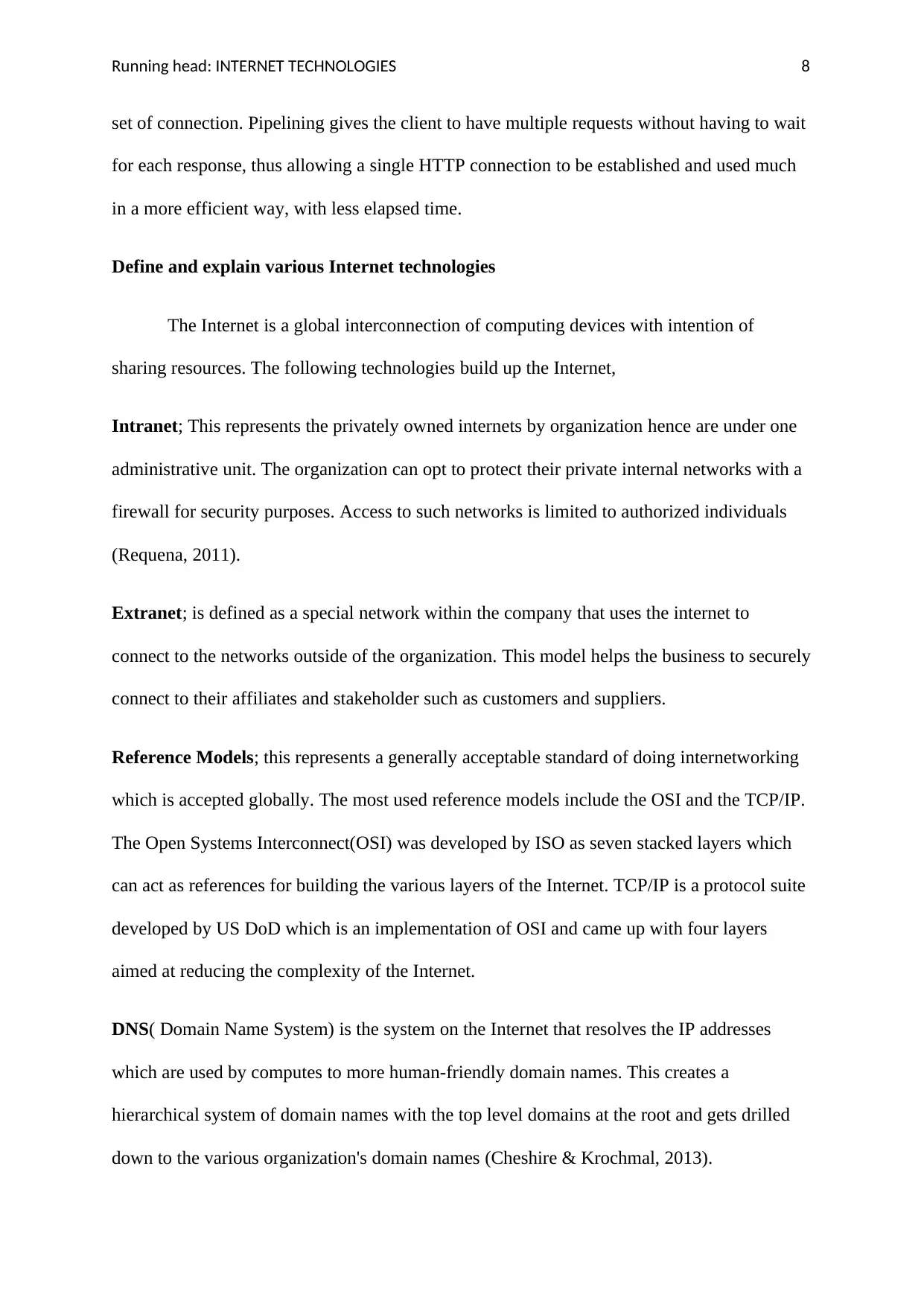
Running head: INTERNET TECHNOLOGIES 8
set of connection. Pipelining gives the client to have multiple requests without having to wait
for each response, thus allowing a single HTTP connection to be established and used much
in a more efficient way, with less elapsed time.
Define and explain various Internet technologies
The Internet is a global interconnection of computing devices with intention of
sharing resources. The following technologies build up the Internet,
Intranet; This represents the privately owned internets by organization hence are under one
administrative unit. The organization can opt to protect their private internal networks with a
firewall for security purposes. Access to such networks is limited to authorized individuals
(Requena, 2011).
Extranet; is defined as a special network within the company that uses the internet to
connect to the networks outside of the organization. This model helps the business to securely
connect to their affiliates and stakeholder such as customers and suppliers.
Reference Models; this represents a generally acceptable standard of doing internetworking
which is accepted globally. The most used reference models include the OSI and the TCP/IP.
The Open Systems Interconnect(OSI) was developed by ISO as seven stacked layers which
can act as references for building the various layers of the Internet. TCP/IP is a protocol suite
developed by US DoD which is an implementation of OSI and came up with four layers
aimed at reducing the complexity of the Internet.
DNS( Domain Name System) is the system on the Internet that resolves the IP addresses
which are used by computes to more human-friendly domain names. This creates a
hierarchical system of domain names with the top level domains at the root and gets drilled
down to the various organization's domain names (Cheshire & Krochmal, 2013).
set of connection. Pipelining gives the client to have multiple requests without having to wait
for each response, thus allowing a single HTTP connection to be established and used much
in a more efficient way, with less elapsed time.
Define and explain various Internet technologies
The Internet is a global interconnection of computing devices with intention of
sharing resources. The following technologies build up the Internet,
Intranet; This represents the privately owned internets by organization hence are under one
administrative unit. The organization can opt to protect their private internal networks with a
firewall for security purposes. Access to such networks is limited to authorized individuals
(Requena, 2011).
Extranet; is defined as a special network within the company that uses the internet to
connect to the networks outside of the organization. This model helps the business to securely
connect to their affiliates and stakeholder such as customers and suppliers.
Reference Models; this represents a generally acceptable standard of doing internetworking
which is accepted globally. The most used reference models include the OSI and the TCP/IP.
The Open Systems Interconnect(OSI) was developed by ISO as seven stacked layers which
can act as references for building the various layers of the Internet. TCP/IP is a protocol suite
developed by US DoD which is an implementation of OSI and came up with four layers
aimed at reducing the complexity of the Internet.
DNS( Domain Name System) is the system on the Internet that resolves the IP addresses
which are used by computes to more human-friendly domain names. This creates a
hierarchical system of domain names with the top level domains at the root and gets drilled
down to the various organization's domain names (Cheshire & Krochmal, 2013).
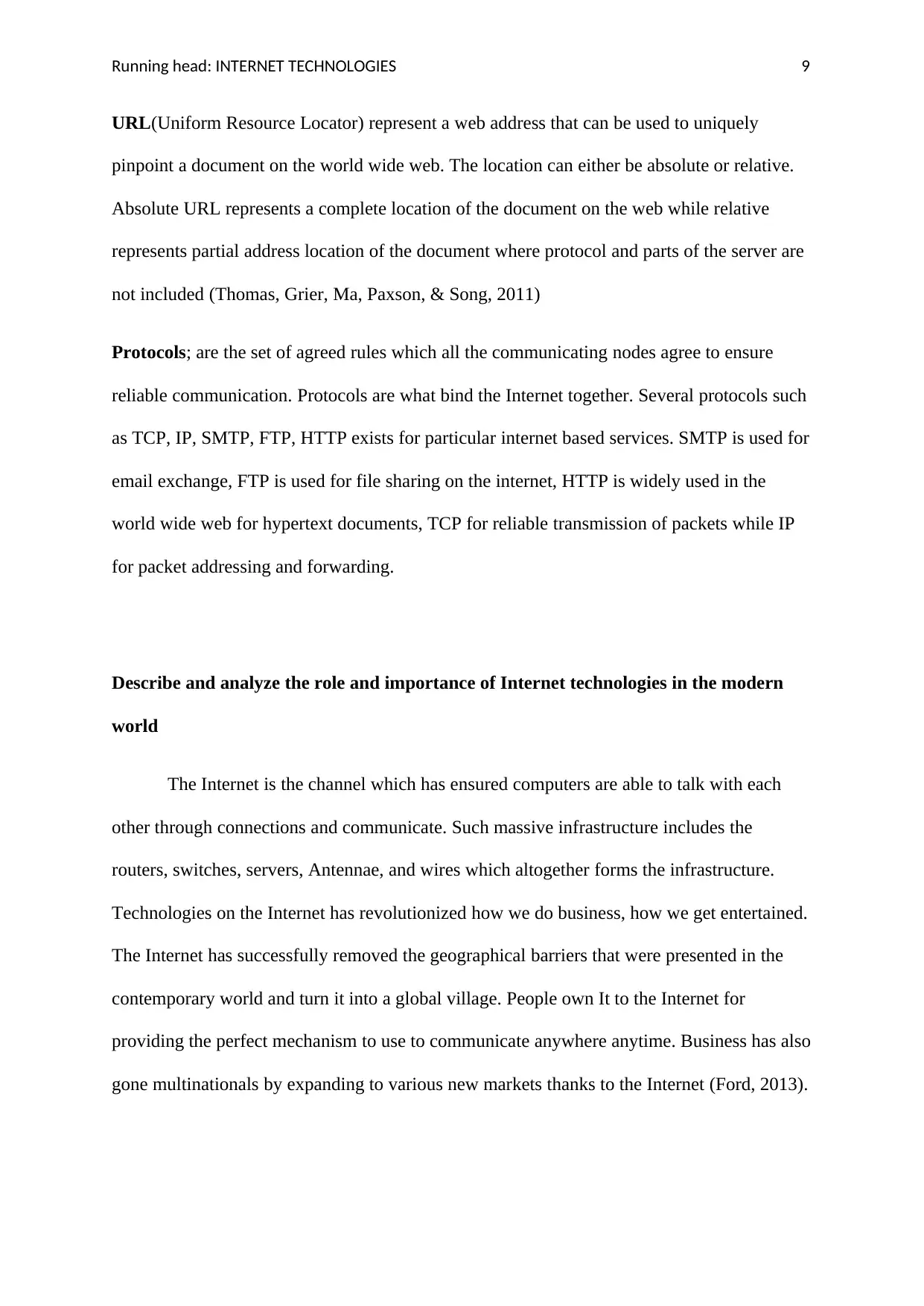
Running head: INTERNET TECHNOLOGIES 9
URL(Uniform Resource Locator) represent a web address that can be used to uniquely
pinpoint a document on the world wide web. The location can either be absolute or relative.
Absolute URL represents a complete location of the document on the web while relative
represents partial address location of the document where protocol and parts of the server are
not included (Thomas, Grier, Ma, Paxson, & Song, 2011)
Protocols; are the set of agreed rules which all the communicating nodes agree to ensure
reliable communication. Protocols are what bind the Internet together. Several protocols such
as TCP, IP, SMTP, FTP, HTTP exists for particular internet based services. SMTP is used for
email exchange, FTP is used for file sharing on the internet, HTTP is widely used in the
world wide web for hypertext documents, TCP for reliable transmission of packets while IP
for packet addressing and forwarding.
Describe and analyze the role and importance of Internet technologies in the modern
world
The Internet is the channel which has ensured computers are able to talk with each
other through connections and communicate. Such massive infrastructure includes the
routers, switches, servers, Antennae, and wires which altogether forms the infrastructure.
Technologies on the Internet has revolutionized how we do business, how we get entertained.
The Internet has successfully removed the geographical barriers that were presented in the
contemporary world and turn it into a global village. People own It to the Internet for
providing the perfect mechanism to use to communicate anywhere anytime. Business has also
gone multinationals by expanding to various new markets thanks to the Internet (Ford, 2013).
URL(Uniform Resource Locator) represent a web address that can be used to uniquely
pinpoint a document on the world wide web. The location can either be absolute or relative.
Absolute URL represents a complete location of the document on the web while relative
represents partial address location of the document where protocol and parts of the server are
not included (Thomas, Grier, Ma, Paxson, & Song, 2011)
Protocols; are the set of agreed rules which all the communicating nodes agree to ensure
reliable communication. Protocols are what bind the Internet together. Several protocols such
as TCP, IP, SMTP, FTP, HTTP exists for particular internet based services. SMTP is used for
email exchange, FTP is used for file sharing on the internet, HTTP is widely used in the
world wide web for hypertext documents, TCP for reliable transmission of packets while IP
for packet addressing and forwarding.
Describe and analyze the role and importance of Internet technologies in the modern
world
The Internet is the channel which has ensured computers are able to talk with each
other through connections and communicate. Such massive infrastructure includes the
routers, switches, servers, Antennae, and wires which altogether forms the infrastructure.
Technologies on the Internet has revolutionized how we do business, how we get entertained.
The Internet has successfully removed the geographical barriers that were presented in the
contemporary world and turn it into a global village. People own It to the Internet for
providing the perfect mechanism to use to communicate anywhere anytime. Business has also
gone multinationals by expanding to various new markets thanks to the Internet (Ford, 2013).
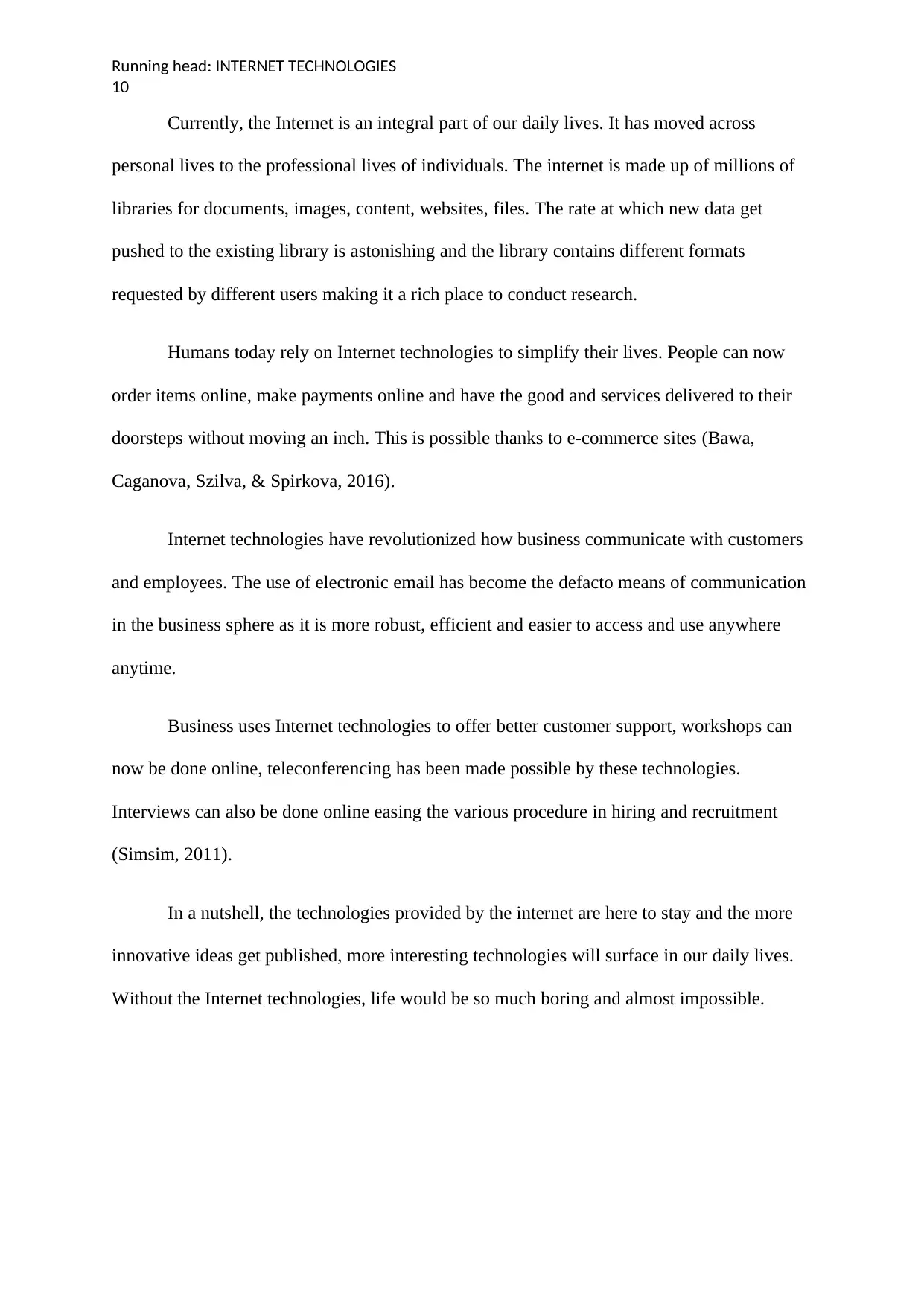
Running head: INTERNET TECHNOLOGIES
10
Currently, the Internet is an integral part of our daily lives. It has moved across
personal lives to the professional lives of individuals. The internet is made up of millions of
libraries for documents, images, content, websites, files. The rate at which new data get
pushed to the existing library is astonishing and the library contains different formats
requested by different users making it a rich place to conduct research.
Humans today rely on Internet technologies to simplify their lives. People can now
order items online, make payments online and have the good and services delivered to their
doorsteps without moving an inch. This is possible thanks to e-commerce sites (Bawa,
Caganova, Szilva, & Spirkova, 2016).
Internet technologies have revolutionized how business communicate with customers
and employees. The use of electronic email has become the defacto means of communication
in the business sphere as it is more robust, efficient and easier to access and use anywhere
anytime.
Business uses Internet technologies to offer better customer support, workshops can
now be done online, teleconferencing has been made possible by these technologies.
Interviews can also be done online easing the various procedure in hiring and recruitment
(Simsim, 2011).
In a nutshell, the technologies provided by the internet are here to stay and the more
innovative ideas get published, more interesting technologies will surface in our daily lives.
Without the Internet technologies, life would be so much boring and almost impossible.
10
Currently, the Internet is an integral part of our daily lives. It has moved across
personal lives to the professional lives of individuals. The internet is made up of millions of
libraries for documents, images, content, websites, files. The rate at which new data get
pushed to the existing library is astonishing and the library contains different formats
requested by different users making it a rich place to conduct research.
Humans today rely on Internet technologies to simplify their lives. People can now
order items online, make payments online and have the good and services delivered to their
doorsteps without moving an inch. This is possible thanks to e-commerce sites (Bawa,
Caganova, Szilva, & Spirkova, 2016).
Internet technologies have revolutionized how business communicate with customers
and employees. The use of electronic email has become the defacto means of communication
in the business sphere as it is more robust, efficient and easier to access and use anywhere
anytime.
Business uses Internet technologies to offer better customer support, workshops can
now be done online, teleconferencing has been made possible by these technologies.
Interviews can also be done online easing the various procedure in hiring and recruitment
(Simsim, 2011).
In a nutshell, the technologies provided by the internet are here to stay and the more
innovative ideas get published, more interesting technologies will surface in our daily lives.
Without the Internet technologies, life would be so much boring and almost impossible.
Secure Best Marks with AI Grader
Need help grading? Try our AI Grader for instant feedback on your assignments.

Running head: INTERNET TECHNOLOGIES
11
Explain different application layer services
The application layer of the Internet is those network aware services that are offered by the
Internet. They include the following services,
DNS which stands for the domain name services. Its main function is to provide the
service of resolving the domain names to its equivalent IP addresses so that the computers
can handle them. Computers generally communicate with IP which is 32-bit numbers but
human beings find the use of domain names more memorizable and hence more recognizable.
To resolve the domain names to IP, the DNS application layer service is used (Requena,
2011).
Telnet is an application layer service that is mainly is in remote connection to another
node or terminal on the Internet. This enables administrators to have access to the various end
devices and nodes anywhere anytime by using the services of the telnet protocol
The email which stands for electronic mail is an application layer service which
allows the users to send and receive webmails over the internet from email clients. The email
service provides an additional opportunity for users not connected to the internet to store the
emails for offline reading. This makes it one of the most important internet service to
business people (Infante-Moro, Infante-Moro, Martínez-López, & García-Ordaz, 2016).
DHCP is an application server that provides a dynamic host configuration whereby
hosts in the network get their configuration information such as the IP address, default
gateway address and the DNS server addresses automatically without an administrator having
to manually or statically configure them (Buckler, 2013). This services, therefore, provides a
11
Explain different application layer services
The application layer of the Internet is those network aware services that are offered by the
Internet. They include the following services,
DNS which stands for the domain name services. Its main function is to provide the
service of resolving the domain names to its equivalent IP addresses so that the computers
can handle them. Computers generally communicate with IP which is 32-bit numbers but
human beings find the use of domain names more memorizable and hence more recognizable.
To resolve the domain names to IP, the DNS application layer service is used (Requena,
2011).
Telnet is an application layer service that is mainly is in remote connection to another
node or terminal on the Internet. This enables administrators to have access to the various end
devices and nodes anywhere anytime by using the services of the telnet protocol
The email which stands for electronic mail is an application layer service which
allows the users to send and receive webmails over the internet from email clients. The email
service provides an additional opportunity for users not connected to the internet to store the
emails for offline reading. This makes it one of the most important internet service to
business people (Infante-Moro, Infante-Moro, Martínez-López, & García-Ordaz, 2016).
DHCP is an application server that provides a dynamic host configuration whereby
hosts in the network get their configuration information such as the IP address, default
gateway address and the DNS server addresses automatically without an administrator having
to manually or statically configure them (Buckler, 2013). This services, therefore, provides a
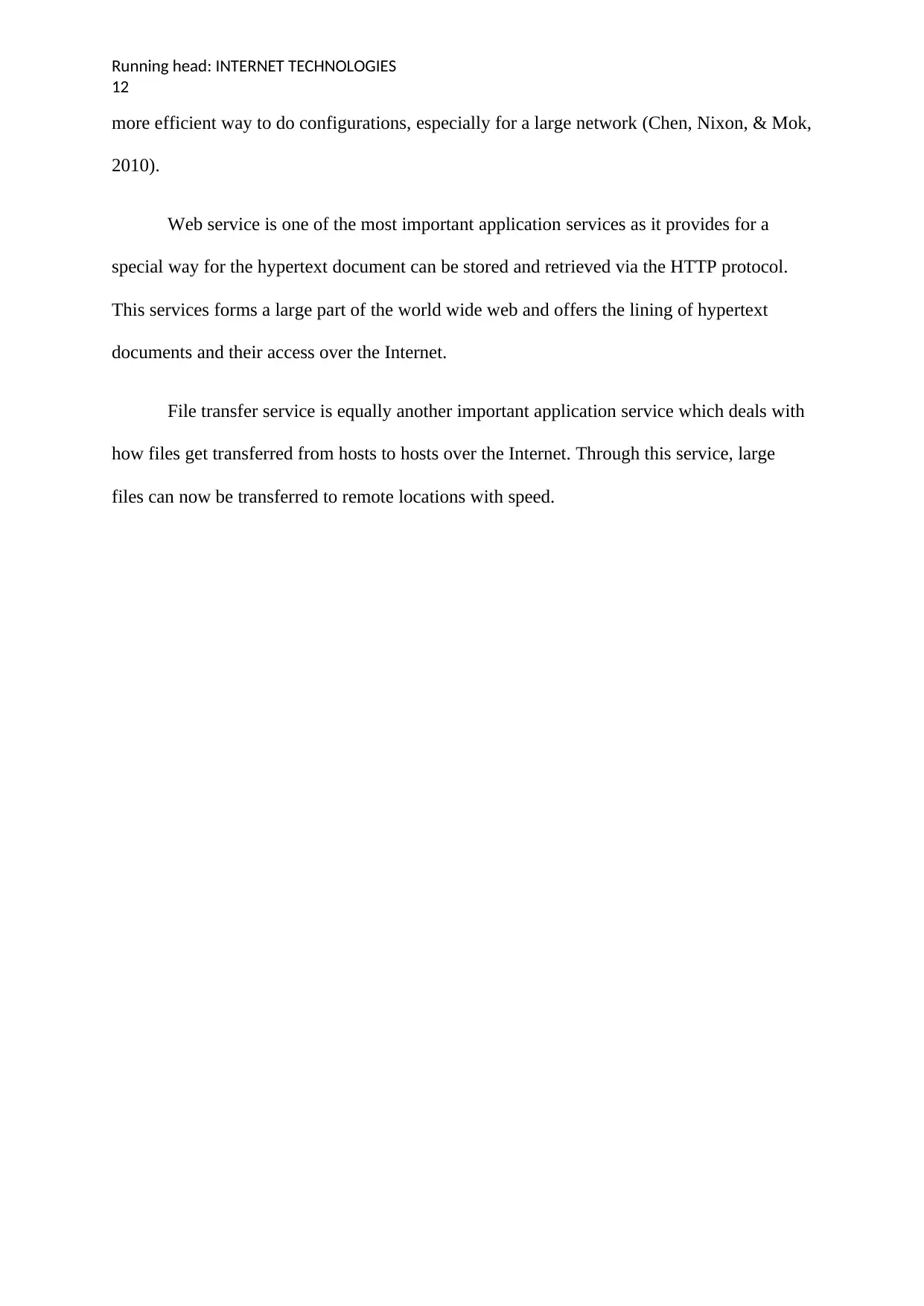
Running head: INTERNET TECHNOLOGIES
12
more efficient way to do configurations, especially for a large network (Chen, Nixon, & Mok,
2010).
Web service is one of the most important application services as it provides for a
special way for the hypertext document can be stored and retrieved via the HTTP protocol.
This services forms a large part of the world wide web and offers the lining of hypertext
documents and their access over the Internet.
File transfer service is equally another important application service which deals with
how files get transferred from hosts to hosts over the Internet. Through this service, large
files can now be transferred to remote locations with speed.
12
more efficient way to do configurations, especially for a large network (Chen, Nixon, & Mok,
2010).
Web service is one of the most important application services as it provides for a
special way for the hypertext document can be stored and retrieved via the HTTP protocol.
This services forms a large part of the world wide web and offers the lining of hypertext
documents and their access over the Internet.
File transfer service is equally another important application service which deals with
how files get transferred from hosts to hosts over the Internet. Through this service, large
files can now be transferred to remote locations with speed.

Running head: INTERNET TECHNOLOGIES
13
References
Bawa, M., Caganova, D., Szilva, I., & Spirkova, D. (2016). Importance of internet of things
and big data in building smart city and what would be its challenges. In Smart City
360° (pp. 605–616). Springer.
Bosco, G., Poggiolini, P., Carena, A., Curri, V., & Forghieri, F. (2011). Analytical results on
channel capacity in uncompensated optical links with coherent detection. Optics
Express, 19(26), B440–B451.
Buckler, D. (2013). Systems and methods for detecting the insertion of poisoned DNS server
addresses into DHCP servers. Google Patents.
Chen, D., Nixon, M., & Mok, A. (2010). Why wirelesshart. In WirelessHARTTM (pp. 195–
199). Springer.
Cheshire, S., & Krochmal, M. (2013). DNS-based service discovery.
Ford, E. (2013). Defining and characterizing open peer review: A review of the literature.
Journal of Scholarly Publishing, 44(4), 311–326.
Infante-Moro, A., Infante-Moro, J.-C., Martínez-López, F.-J., & García-Ordaz, M. (2016).
The importance of Internet and Online Social Networks in the Spanish Hotel Sector.
Applied Computer Science, 12(1).
Requena, J. C. (2011). System and methods for using an application layer control protocol
transporting spatial location information pertaining to devices connected to wired
and wireless internet protocol networks. Google Patents.
Simsim, M. T. (2011). Internet usage and user preferences in Saudi Arabia. Journal of King
Saud University-Engineering Sciences, 23(2), 101–107.
Thomas, K., Grier, C., Ma, J., Paxson, V., & Song, D. (2011). Design and evaluation of a
real-time url spam filtering service. In Security and Privacy (SP), 2011 IEEE
Symposium on (pp. 447–462). IEEE.
13
References
Bawa, M., Caganova, D., Szilva, I., & Spirkova, D. (2016). Importance of internet of things
and big data in building smart city and what would be its challenges. In Smart City
360° (pp. 605–616). Springer.
Bosco, G., Poggiolini, P., Carena, A., Curri, V., & Forghieri, F. (2011). Analytical results on
channel capacity in uncompensated optical links with coherent detection. Optics
Express, 19(26), B440–B451.
Buckler, D. (2013). Systems and methods for detecting the insertion of poisoned DNS server
addresses into DHCP servers. Google Patents.
Chen, D., Nixon, M., & Mok, A. (2010). Why wirelesshart. In WirelessHARTTM (pp. 195–
199). Springer.
Cheshire, S., & Krochmal, M. (2013). DNS-based service discovery.
Ford, E. (2013). Defining and characterizing open peer review: A review of the literature.
Journal of Scholarly Publishing, 44(4), 311–326.
Infante-Moro, A., Infante-Moro, J.-C., Martínez-López, F.-J., & García-Ordaz, M. (2016).
The importance of Internet and Online Social Networks in the Spanish Hotel Sector.
Applied Computer Science, 12(1).
Requena, J. C. (2011). System and methods for using an application layer control protocol
transporting spatial location information pertaining to devices connected to wired
and wireless internet protocol networks. Google Patents.
Simsim, M. T. (2011). Internet usage and user preferences in Saudi Arabia. Journal of King
Saud University-Engineering Sciences, 23(2), 101–107.
Thomas, K., Grier, C., Ma, J., Paxson, V., & Song, D. (2011). Design and evaluation of a
real-time url spam filtering service. In Security and Privacy (SP), 2011 IEEE
Symposium on (pp. 447–462). IEEE.
1 out of 13
Related Documents
Your All-in-One AI-Powered Toolkit for Academic Success.
+13062052269
info@desklib.com
Available 24*7 on WhatsApp / Email
![[object Object]](/_next/static/media/star-bottom.7253800d.svg)
Unlock your academic potential
© 2024 | Zucol Services PVT LTD | All rights reserved.




